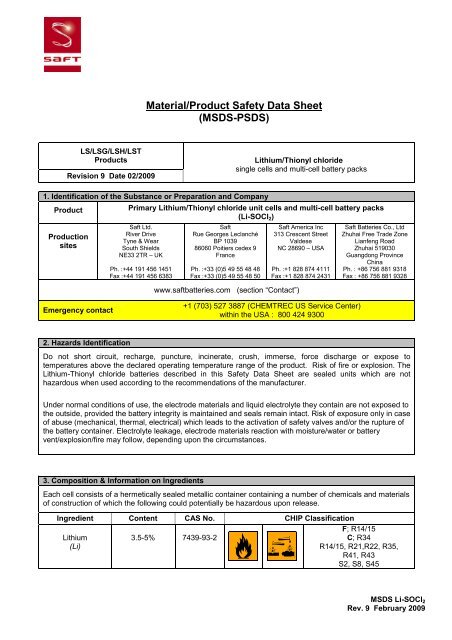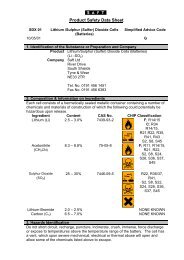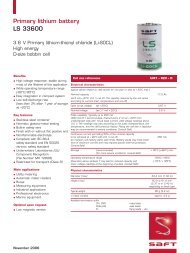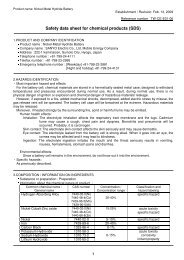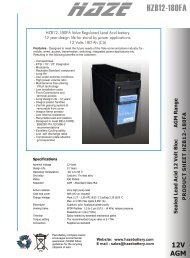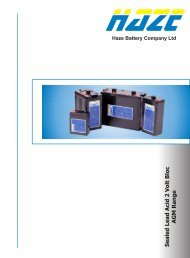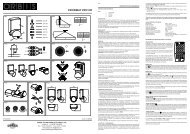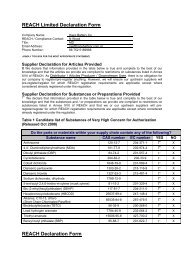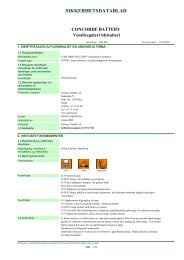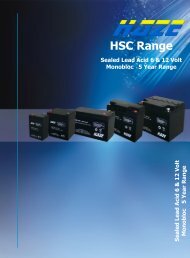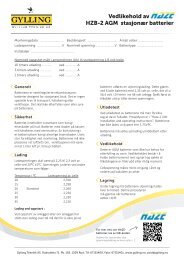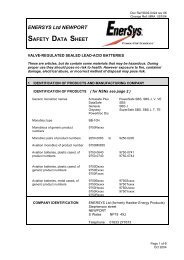Material/Product Safety Data Sheet (MSDS-PSDS) - Battery Web
Material/Product Safety Data Sheet (MSDS-PSDS) - Battery Web
Material/Product Safety Data Sheet (MSDS-PSDS) - Battery Web
Create successful ePaper yourself
Turn your PDF publications into a flip-book with our unique Google optimized e-Paper software.
<strong>Material</strong>/<strong>Product</strong> <strong>Safety</strong> <strong>Data</strong> <strong>Sheet</strong>(<strong>MSDS</strong>-<strong>PSDS</strong>)LS/LSG/LSH/LST<strong>Product</strong>sRevision 9 Date 02/2009Lithium/Thionyl chloridesingle cells and multi-cell battery packs1. Identification of the Substance or Preparation and Company<strong>Product</strong><strong>Product</strong>ionsitesPrimary Lithium/Thionyl chloride unit cells and multi-cell battery packs(Li-SOCl 2 )Saft Ltd.River DriveTyne & WearSouth ShieldsNE33 2TR – UKPh. :+44 191 456 1451Fax :+44 191 456 6383SaftRue Georges LeclanchéBP 103986060 Poitiers cedex 9FrancePh. :+33 (0)5 49 55 48 48Fax :+33 (0)5 49 55 48 50www.saftbatteries.com (section “Contact”)Saft America Inc313 Crescent StreetValdeseNC 28690 – USAPh. :+1 828 874 4111Fax :+1 828 874 2431Saft Batteries Co., LtdZhuhai Free Trade ZoneLianfeng RoadZhuhai 519030Guangdong ProvinceChinaPh. : +86 756 881 9318Fax : +86 756 881 9328Emergency contact+1 (703) 527 3887 (CHEMTREC US Service Center)within the USA : 800 424 93002. Hazards IdentificationDo not short circuit, recharge, puncture, incinerate, crush, immerse, force discharge or expose totemperatures above the declared operating temperature range of the product. Risk of fire or explosion. TheLithium-Thionyl chloride batteries described in this <strong>Safety</strong> <strong>Data</strong> <strong>Sheet</strong> are sealed units which are nothazardous when used according to the recommendations of the manufacturer.Under normal conditions of use, the electrode materials and liquid electrolyte they contain are not exposed tothe outside, provided the battery integrity is maintained and seals remain intact. Risk of exposure only in caseof abuse (mechanical, thermal, electrical) which leads to the activation of safety valves and/or the rupture ofthe battery container. Electrolyte leakage, electrode materials reaction with moisture/water or batteryvent/explosion/fire may follow, depending upon the circumstances.3. Composition & Information on IngredientsEach cell consists of a hermetically sealed metallic container containing a number of chemicals and materialsof construction of which the following could potentially be hazardous upon release.Ingredient Content CAS No. CHIP ClassificationLithium(Li)3.5-5% 7439-93-2F; R14/15C; R34R14/15, R21,R22, R35,R41, R43S2, S8, S45<strong>MSDS</strong> Li-SOCl 2Rev. 9 February 2009
Thionyl chloride(SOCl 2 )40-46% 7719-09-7C; R14, R21, R22, R35,R37, R41,R42/43S2, S8, S24, S26, S36,S37, S45Aluminum chlorideanhydrous(AlCl 3 )Carbon(C n )1-5% 7446-70-0 R14, R22, R37, R41, R43.S2, S8, S22, S24, S26,S36, S453-4% 1333-86-4 NONE KNOWNAmount varies depending on cell size.4. First Aid MeasuresInhalationSkin contactEye contactIngestionFurther treatmentRemove from exposure, rest and keep warm.In severe cases obtain medical attention.Wash off skin thoroughly with water. Remove contaminated clothing and washbefore re-use. In severe cases obtain medical attention.Irrigate thoroughly with water for at least 15 minutes.Obtain medical attention.Wash out mouth thoroughly with water and give plenty of water to drink.Obtain medical attention.All cases of eye contamination, persistent skin irritation and casualties whohave swallowed this substance or been affected by breathing its vapoursshould be seen by a Doctor.5. Fire Fighting MeasuresCO 2 extinguishers or, even preferably, copious quantities of water or water-based foam, can be used to cooldown burning Li- SOCl 2 cells and batteries, as long as the extent of the fire has not progressed to the pointthat the lithium metal they contain is exposed (marked by deep red flames).Do not use for this purpose sand, dry powder or soda ash, graphite powder or fire blankets.Use only metal (Class D) extinguishers on raw lithium.Extinguishing mediaUse water or CO 2 on burning Li-SOCl 2 cells or batteriesand class D fire extinguishing agent only on raw lithium.6. Accidental Release MeasuresRemove personnel from area until fumes dissipate. Do not breathe vapours or touch liquid with bare hands.If the skin has come into contact with the electrolyte, it should be washed thoroughly with water.Sand or earth should be used to absorb any exuded material. Seal leaking battery and contaminatedabsorbent material in plastic bag and dispose of as Special Waste in accordance with local regulations.<strong>MSDS</strong> Li-SOCl 2Rev. 9 February 2009
7. Handling and StorageHandlingStorageOtherDo not crush, pierce, short (+) and (-) battery terminals with conductive(i.e. metal) goods. Do not directly heat or solder. Do not throw into fire.Do not mix batteries of different types and brands. Do not mix new and usedbatteries. Keep batteries in non conductive (i.e. plastic) trays.Store in a cool (preferably below 30°C) and ventilated area, away frommoisture, sources of heat, open flames, food and drink.Keep adequate clearance between walls and batteries.Temperature above 100°C may result in battery leakage and rupture.Since short circuit can cause burns, leakage and rupture hazard, keepbatteries in original packaging until use and do not jumble them.Lithium-Thionyl chloride batteries are not rechargeable and should not betentatively charged.Follow Manufacturers recommendations regarding maximum recommendedcurrents and operating temperature range.Applying pressure on deforming the battery may lead to disassemblyfollowed by eye, skin and throat irritation.8. Exposure Controls & Personal ProtectionCompoundOccupationalSulfur dioxideexposure standardHydrogen chloride8hr TWA1 ppm1 ppm15min TWA1 ppm5 ppmSK--RespiratoryprotectionIn all fire situations, use self-contained breathing apparatus.HandprotectionIn the event of leakage wear gloves.Eyeprotection<strong>Safety</strong> glasses are recommended during handling.OtherIn the event of leakage, wear chemical apron.9. Physical and Chemical PropertiesAppearanceCylindrical or prismatic shapeOdourIf leaking, gives off a pungent corrosive odour.pHNot applicableFlash pointNot applicable unless individual components exposedFlammability Not applicable unless individual components exposedRelative density Not applicable unless individual components exposedSolubility (water) Not applicable unless individual components exposedSolubility (other) Not applicable unless individual components exposed<strong>MSDS</strong> Li-SOCl 2Rev. 9 February 2009
10. Stability and Reactivity<strong>Product</strong> is stable under conditions described in Section 7.Conditions to avoid.Heat above 100 (150°C for the LSH 20-150 cells and the battery packsassembled from them) or incinerate. Deform. Mutilate. Crush. Pierce.DisassembleRecharge. Short circuit. Expose over a long period to humid conditions.<strong>Material</strong>s to avoidOxidising agents, alkalis, water. Avoid electrolyte contact with aluminum or zinc.Hazardousdecomposition<strong>Product</strong>sHydrogen (H 2 ) as well as Lithium oxide (Li 2 O) and Lithium hydroxide (LiOH) dustis produced in case of reaction of lithium metal with water.Chlorine (Cl 2 ), Sulfur dioxide (SO 2 ) and Disulfur dichloride (S 2 Cl 2 ) are producedin case of thermal decomposition of Thionyl chloride above 140°C.Hydrochloric acid (HCl) and Sulfur dioxide (SO 2 ) are produced in case ofreaction of Thionyl chloride with water at room temperature.Hydrochloric acid (HCl) fumes, Lithium oxide, (Li 2 O), Lithium hydroxide (LiOH)and Aluminum hydroxide (Al(OH) 3 ) dust are produced in case of reaction ofLithium tetrachloroaluminate (LiAlCl 4 ) with water.11. Toxicological InformationNone, unless battery ruptures. In the event of exposure to internal contents,corrosive fumes will be very irritating to skin, eyes and mucous membranes.Signs & symptomsOverexposure can cause symptoms of non-fibrotic lung injury and membraneirritation.Inhalation Lung irritant.Skin contact Skin irritantEye contact Eye irritant.Ingestion Tissue damage to throat and gastro-respiratory tract if swallowed.Medical conditionsIn the event of exposure to internal contents, eczema, skin allergies, lunggenerally aggravatedinjuries, asthma and other respiratory disorders may occur.by exposure12. Ecological InformationMammalian effectsEco-toxicityBioaccumulationpotentialEnvironmental fateNone known if used/disposed of correctly.None known if used/disposed of correctly.None known if used/disposed of correctly.None known if used/disposed of correctly.13. Disposal ConsiderationsDo not incinerate, or subject cells to temperatures in excess of 100 o C. Such abuse can result in lossof seal, leakage, and/or cell explosion. Dispose of in accordance with appropriate local regulations.<strong>MSDS</strong> Li-SOCl 2Rev. 9 February 2009
14. Transport InformationNote : when manufacturing a new battery pack, one must assure that it is tested in accordance with the UNModel Regulations, Manual of Tests and Criteria, Part III, subsection 38.3Label for conveyanceUN numbersShipping namesHazard classificationPacking GroupIMDG CodeCASEmS No.F-A , S-IMarine pollutant NoADR Class Class 9For the single cell batteries and multicell battery packs that are non-restrictedto transport (non-assigned to the Miscellaneous Class 9), use lithium batteriesinside label.For the single cell batteries and multicell battery packs which are restricted totransport (assigned to Class 9), use Class 9 Miscellaneous Dangerous Goodsand UN Identification Number labels.In all cases, refer to the product transport certificate issued by theManufacturer.UN 3090 (shipment of cells and batteries in bulk)UN 3091 (cells and batteries contained in equipment or packed with it)Lithium Metal BatteriesDepending on their lithium metal content, some single cells and small multicellbattery packs may be non-assigned to Class 9 (Refer to Transport Certificate)II3090 (Li batteries)3091 (Li batteries contained in equipment or packed with it)15. Regulatory InformationRegulations specifically applicable to the product:- ACGIH and OSHA: see exposure limits of the internal ingredients of the battery in section 8.- IATA/ICAO (air transportation): UN 3090 or UN 3091- IMDG (sea transportation) : UN 3090 or UN 3091- Transportation within the US-DOT, 49 Code of Federal RegulationsRisk phrasesLithium(Li)Thionylchloride(SOCl 2 )Aluminumchlorideanhydrous(AlCl 3 )R14/15R21R22R35R41R42/43R14R22R35R37R41R42/43R14R22R37R41R43Reacts violently with water, liberating extremelyflammable gases.Harmful in contact with skin.Harmful if swallowed.Causes burns.Risk of serious damage to eye.May cause sensitization by inhalation and skincontact.Reacts with water.Harmful if swallowed.Causes burns.Irritating to respiratory system.Risk of serious damage to eye.May cause sensitization by inhalation and skincontact.Reacts with water.Harmful if swallowed.Irritating to respiratory system.Risk of serious damage to eye.May cause sensitization by skin contact.<strong>MSDS</strong> Li-SOCl 2Rev. 9 February 2009
<strong>Safety</strong> phrasesUKregulatory referencesLithium(Li)Thionylchloride(SOCl 2 )Aluminumchlorideanhydrous(AlCl 3 )S2S8S45S2S8S24S26S36S37S45S2S8 S22S24 S26S36Keep out of reach of childrenKeep away from moistureIn case of incident, seek medical attention.Keep out of reach of children.Keep away from moisture.Avoid contact with skin.In case of contact with eyes, rinse immediatelywith plenty of water.Wear suitable protective clothing.Wear suitable gloves.In case of incident, seek medical attention.Keep out of reach of children.Keep away from moisture.Do not breathe dust.Avoid contact with skin.In case of contact with eyes, rinse immediatelywith plenty of water.Wear suitable protective clothing.Classified under CHIP16. Other InformationThis information has been compiled from sources considered to be dependable and is, to the best of ourknowledge and belief, accurate and reliable as of the date compiled. However, no representation, warranty(either expressed or implied ) or guarantee is made to the accuracy, reliability or completeness of theinformation contained herein.This information relates to the specific materials designated and may not be valid for such material used incombination with any other materials or in any process. It is the user’s responsibility to satisfy himself as tothe suitability and completeness of this information for his particular use.Saft does not accept liability for any loss or damage that may occur, whether direct, indirect, incidental orconsequential, from the use of this information. Saft does not offer warranty against patent infringement.Edition 9 – February 2009Signature _____________________Nicolas PaquinLithium <strong>Product</strong> Manager<strong>MSDS</strong> Li-SOCl 2Rev. 9 February 2009


